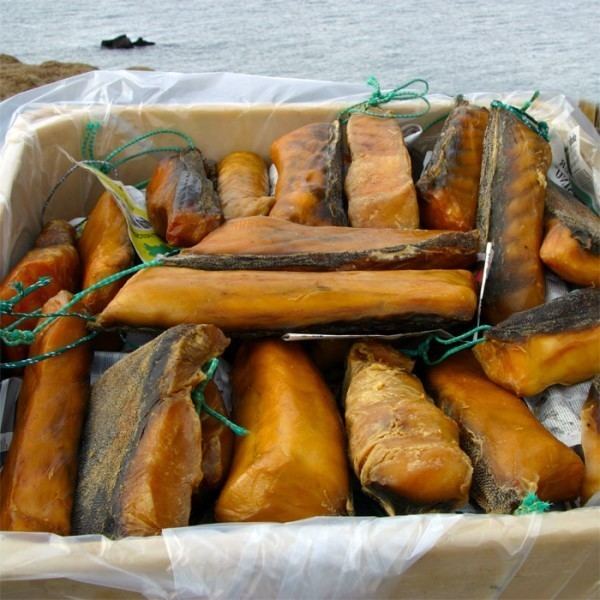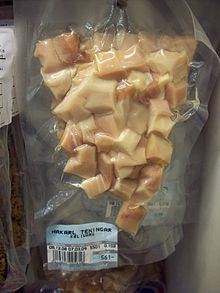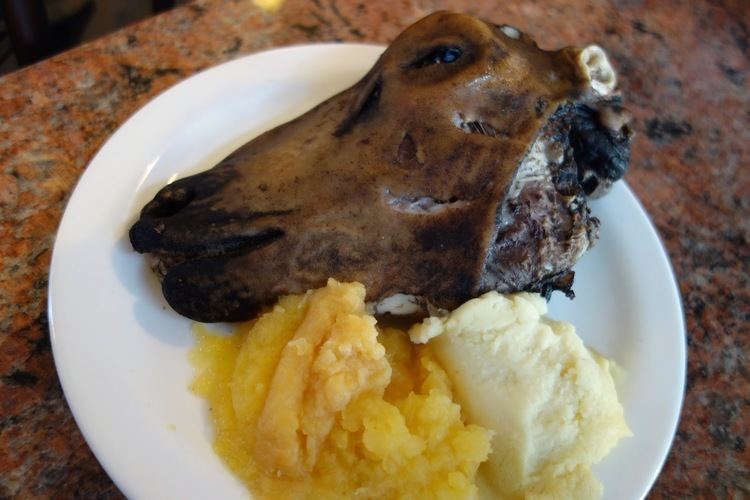 | ||
Similar Casu marzu, brennivín, Surströmming, San‑nakji, Balut | ||
Martin eating h karl
Kæstur hákarl ([ˈhauːkʰardl̥]) (Icelandic for "treated shark") is a national dish of Iceland consisting of a Greenland shark (Somniosus microcephalus) or other sleeper shark which has been cured with a particular fermentation process and hung to dry for four to five months. Kæstur hákarl has a strong ammonia-rich smell and fishy taste.
Contents

Kæstur hákarl is readily available in Icelandic stores and is eaten year-round, but is also served as part of a þorramatur, a selection of traditional Icelandic food served at þorrablót in midwinter.

Consumption

Kæstur hákarl contains a large amount of ammonia and has a strong smell, similar to many cleaning products. It is often served in cubes on toothpicks. Those new to it may gag involuntarily on the first attempt to eat it because of the high ammonia content. First-timers are sometimes advised to pinch their nose while taking the first bite, as the smell is much stronger than the taste. It is often eaten with a shot of the local spirit, a type of akvavit called brennivín.

It comes in two varieties; chewy and reddish glerhákarl (lit. "glassy shark") from the belly, and white and soft skyrhákarl (lit. "skyr shark") from the body.
Preparation

The meat of the Greenland shark is poisonous when fresh, due to a high content of urea and trimethylamine oxide, but may be consumed after being processed.
The traditional method is by gutting and beheading a Greenland or sleeper shark and placing it in a shallow hole dug in gravelly sand, with the now cleaned cavity resting on a small mound of sand. The shark is then covered with sand and gravel, and stones are placed on top of the sand in order to press the shark. In this way the fluids are pressed out of the body. The shark ferments in this fashion for 6–12 weeks depending on the season. Following this curing period, the shark is then cut into strips and hung to dry for several months. During this drying period a brown crust will develop, which is removed prior to cutting the shark into small pieces and serving.
It is possible to witness the traditional preparation process at Bjarnarhöfn Shark Museum on Snæfellsnes.
The modern method is just to press the shark's meat in a large drained plastic container.
Reactions
Chef Anthony Bourdain described kæstur hákarl as "the single worst, most disgusting and terrible tasting thing" he has ever eaten.
Chef Gordon Ramsay challenged James May to sample three "delicacies" (Laotian snake whiskey, bull penis, and kæstur hákarl) on The F Word; after eating kæstur hákarl, Ramsay spat it out, although May kept his down. May reacted with, "You disappoint me, Ramsay" and offered to do it again.
On season two's Iceland episode of Travel Channel's Bizarre Foods with Andrew Zimmern, Andrew Zimmern described the smell as reminding him of "some of the most horrific things I've ever breathed in my life," but said it tasted much better than it smelled. He described the taste as "sweet, nutty and only faintly fishy." Nonetheless, he did note of kæstur hákarl: "That's hardcore. That's serious food. You don't want to mess with that. That's not for beginners."
Archaeologist Neil Oliver tasted it in the BBC documentary Vikings as part of examining the Viking diet. He described it as reminiscent of "blue cheese but a hundred times stronger".
